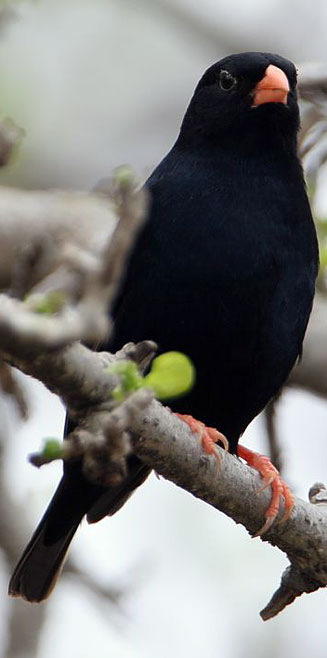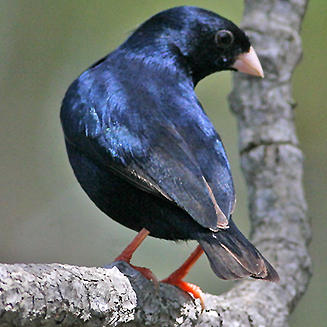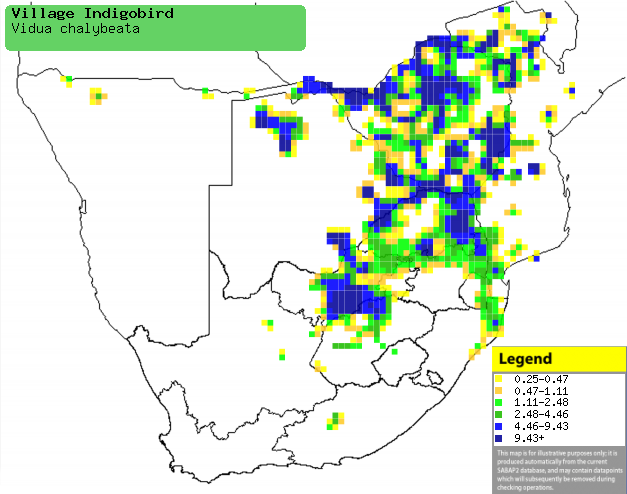|
Vidua chalybeata (Village
indigobird, Steelblue widowfinch)
Staalblouvinkie [Afrikaans]; Staalvink [Dutch]; Combassou
du Sénégal [French]; Rotschnabel-atlaswitwe [German]; Viúva-azul [Portuguese]
Life
> Eukaryotes >
Opisthokonta
> Metazoa (animals) >
Bilateria >
Deuterostomia > Chordata >
Craniata > Vertebrata (vertebrates) > Gnathostomata (jawed
vertebrates) > Teleostomi (teleost fish) > Osteichthyes (bony fish) > Class:
Sarcopterygii (lobe-finned
fish) > Stegocephalia (terrestrial
vertebrates) > Tetrapoda
(four-legged vertebrates) > Reptiliomorpha > Amniota >
Reptilia (reptiles) >
Romeriida > Diapsida > Archosauromorpha > Archosauria >
Dinosauria
(dinosaurs) > Saurischia > Theropoda (bipedal predatory dinosaurs) >
Coelurosauria > Maniraptora > Aves
(birds) >
Order: Passeriformes > Family: Viduidae
 |
 |
 |
|
Village indigobird male, Kruger National Park,
South Africa. [photo Trevor Hardaker ©] |
Top right: Village indigobird male, Gambia. [photo Martin Goodey
©]Bottom right: Village indigobird
female. [photo
Jeff Poklen
©] |
Distribution and habitat
Occurs in a horizontal band from Senegal to Ethiopia,
extending south through Tanzania, Zambia and Malawi to southern Africa. Here it
is locally common in Zimbabwe, Mozambique, northern and south-eastern Botswana,
northern Namibia and north-eastern and northern South Africa, generally
preferring Acacia savanna and thorny thickets along rivers,
Colosphermum mopane (Mopane) woodland near water, edges of cultivated areas,
citrus orchards with patches of grass and gardens in settlements.
|
 |
|
Distribution of Village indigobird in southern
Africa, based on statistical smoothing of the records from first SA Bird
Atlas Project (©
Animal Demography unit, University of
Cape Town; smoothing by Birgit Erni and Francesca Little). Colours range
from dark blue (most common) through to yellow (least common).
See here for the latest distribution
from the SABAP2. |
Food
It mainly eats grass seeds, doing most of its foraging on
the ground, uncovering food in the soil. The following food items have been recorded
in its diet:
- Grass seeds
- Echinochloa colonum (Swamp grass)
- Setaria
- Urochloris
- Dactycynodon
- Insects
Breeding
- Polygynous, territorial brood parasite, using a system whereby each male
owns a territory centered on a perch used for calling. Males chase any male
intruders out of their territory, of both the same species as well as other
indigobirds and whydahs. If a female enters a males territory he escorts her
to his call site while chattering loudly, sometimes giving a calling display
before attempting to mate. Typically in any given area there is one male who
mates with the majority of females, usually because he sings more than the
other males.
- Its most common host is the
Red-billed firefinch
as well as other firefinch species, such as the
Brown firefinch.
- Egg-laying season is from December-June, peaking from March-April.
- The female often finds firefinch nests by listening out for their calls,
or following a bird carrying nest lining. It enters the nest regardless of
whether it is occupied, often removing or eating any existing eggs before
laying one of its own, much to the indignation of the firefinch if present,
who may try to scare off the indigobird unsuccessfully. It lays sets of 1-4
eggs per day, usually laying a total of 22-26 eggs in a breeding season. The
egg usually hatches after about 11-12 days of incubation.
- The chick usually leaves the nest after about 17-18 days, after which it
remains in the care of its host parents for 10-14 days before joining a
flock of indigobirds.
Threats
Not threatened.
References
-
Hockey PAR, Dean WRJ and Ryan PG 2005. Roberts
- Birds of southern Africa, VIIth ed. The Trustees of the John Voelcker
Bird Book Fund, Cape Town.
|
